Amazing
Beyond The Walls of An Intriguing NY Farmhouse Abandoned For Four Decades
While there are approximately eight million households in the very populated State of New York, some are more intriguing than others. Every building has a tale, some telling different stories daily.
Others have extraordinary events that are usually tucked away for years, just waiting to be shared. This particular house waited four decades for someone to uncover the mystery behind its walls.
Bryan Sansivero, a renowned photographer, got wind of the property and sought permission from the city authorities to explore it. It carries you to an entirely different period.

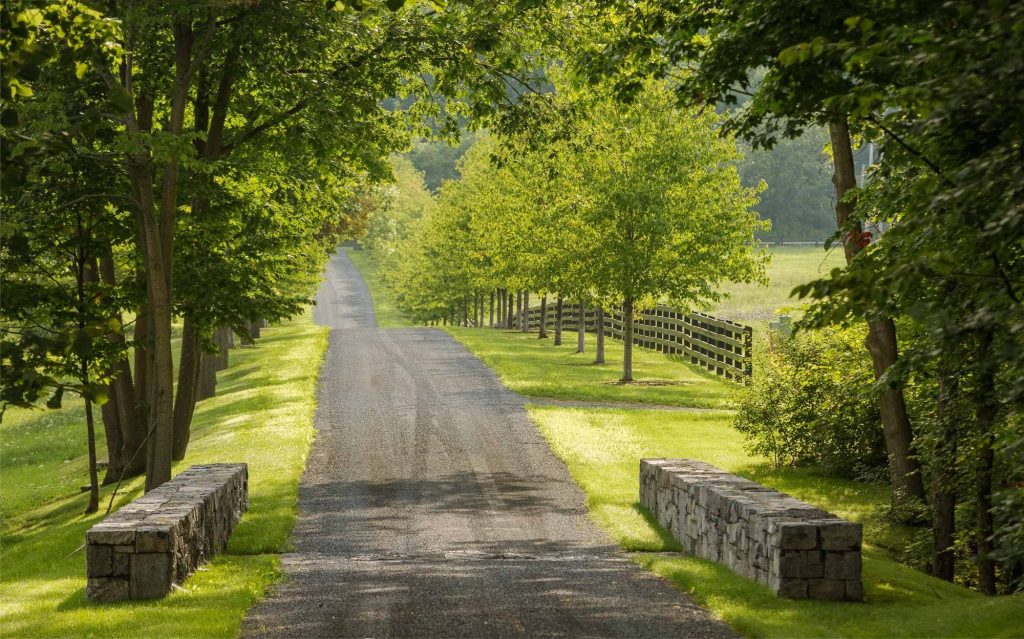
There was no sign out front
Bryan Sansivero was amazed at how well-hidden the farmhouse was. The lengthy driveway follows around to the back of the house.
This is what you’d call hiding in plain sight since a bustling community enveloped it. However, the owners wanted privacy; hence this single-room cabin in the woods could go unnoticed. He says that the place feels like time has paused.
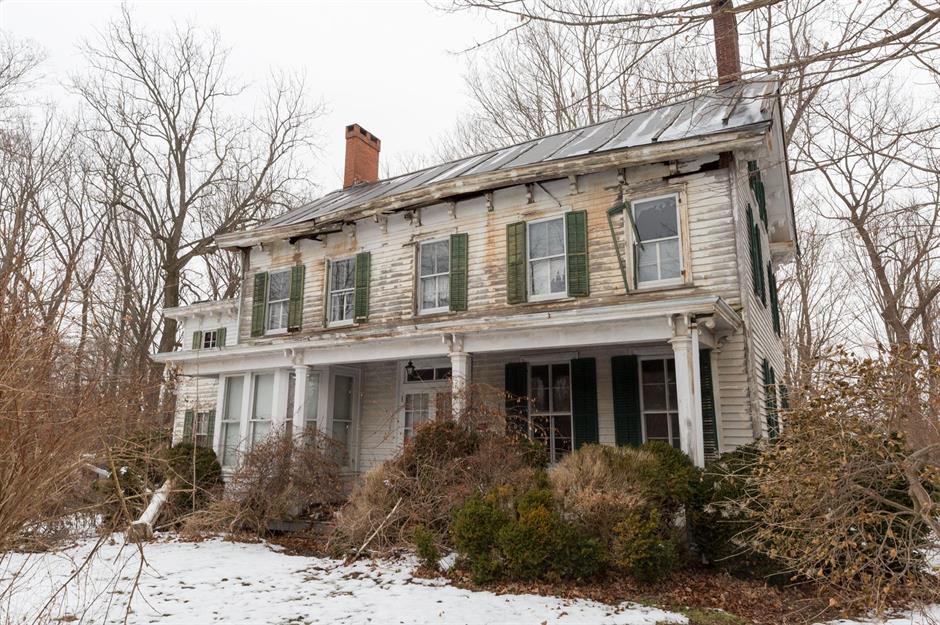
Former Breathtaking Facade Decaying
The Victorian home was once made impressive by its appeal but now is decayed by neglect. Here, we see the main farmhouse, which was built in 1860. The roof has sagged, and one of the columns has fallen.
There are nine acres, a smokery, a garage, an outhouse, a stable, a milk house, a sheep barn, and four smaller barns. Sansivero hopes his pictures will assist in some way to the rehabilitation of a gorgeous and historically meaningful residence.
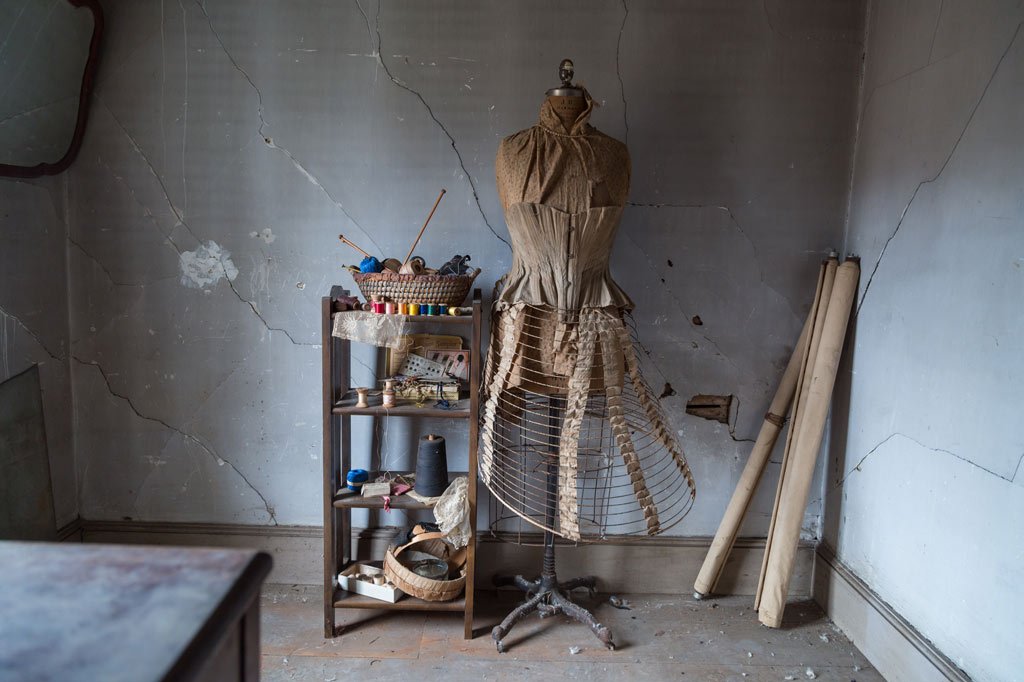
Built Prior to The Civil War
To find the historic farmhouse, you’ll have to head to Commack hamlet, which was once Native American territory. This is in the Suffolk County area of NY.
Urbanization has brought about a higher level of development to the Marion Carll Farm location. The ranch has been in existence since the start of the 18th century, prior to the Civil War.

Neglected, But Loaded With Treasures
Sansivero took photos of the plantation repeatedly, with the permission of the local school district and board. He states that each time he visited, he came upon more items that needed to be highlighted.
There was a vast number of valuable pieces of history. These scarce photographs are reminders of how unique the property was before being abandoned and eventually demolished.
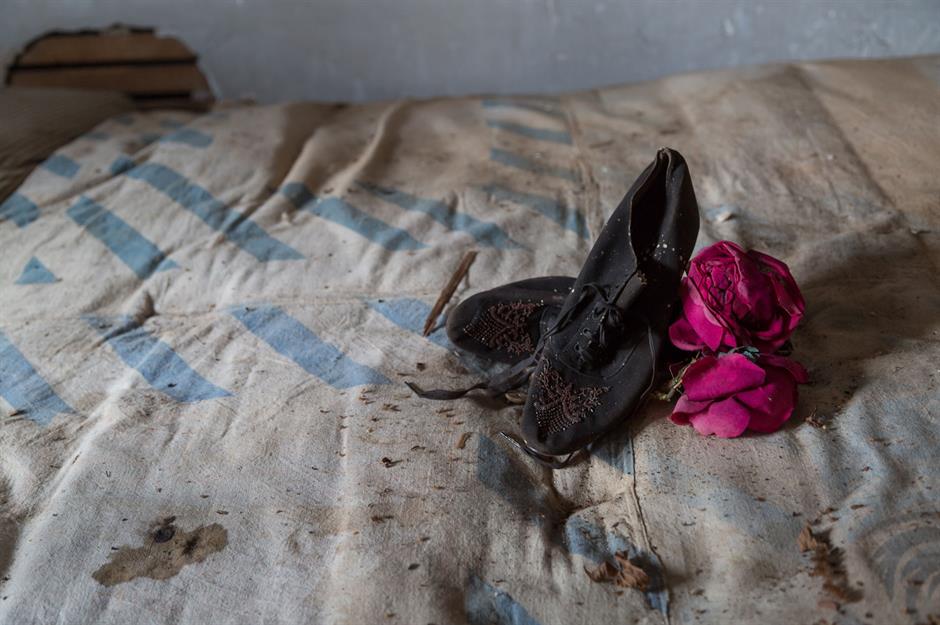
Marion Carll Led a Busy Lifestyle
Marion Carll was a stalwart of the community and greatly respected. She was a school trustee and helped found the first PTA.
Education played an integral part of Carll’s life, so it was no surprise that she willed the house to the Commack School Board and District for academic and chronological objectives. These decorated shoes probably belonged to Carll.
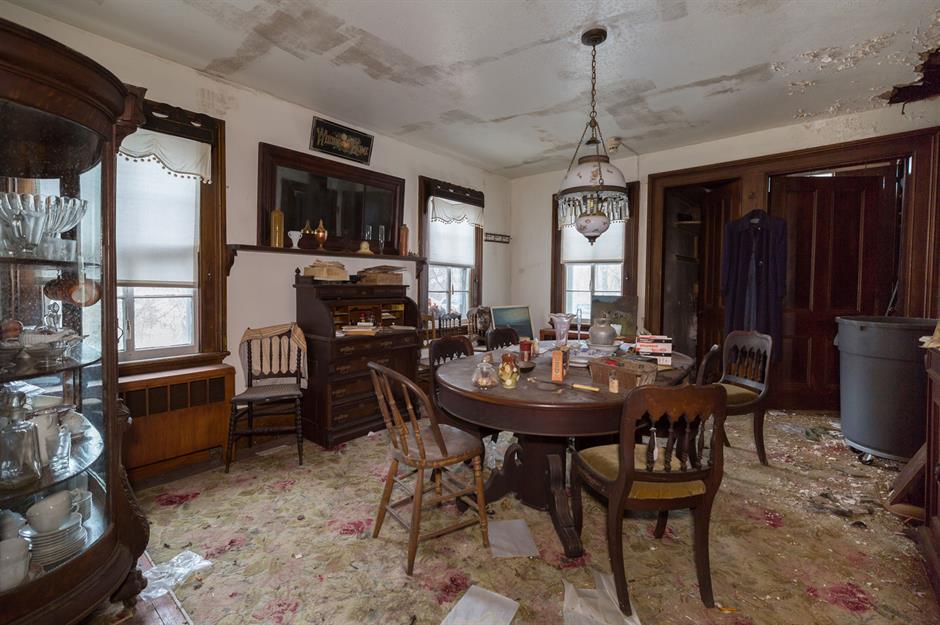
She Tried to Preserve History
As a history buff, Marion Carll aimed to preserve as much of the character of the 18th-century farmhouse as possible and never tried to modernize the residence. As a result, the site has a lot of old vintage collectibles.
Despite being abandoned four decades ago, it appeared as if Marion Carll were living in an entirely different era.
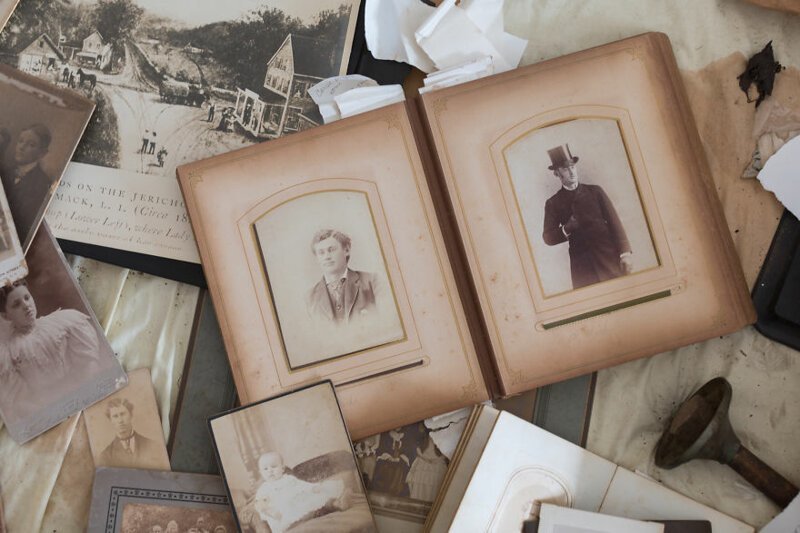
The Home Links to Walt Whitman
The photos document the lives of the Carll family. A local history book, Huntington’s Hidden Past by Kerriann Flanagan Brosky, disclosed some fascinating data regarding the family property.
“The land on which the farm stands, off Commack Road, was originally inhabited by members of the Secatougue Indian tribe. According to a deed of record from 1698, the Indians conveyed the parcel of land to John Skidmore and John Whitman, great-great-great-grandfather of poet Walt Whitman.”

Danger Lurks on the Stairwell
You can see the grand staircase at the front of the house. There’s another home stairway leading to the basement. The stairs on the other flight were not in a decent state.
The photographer notes that they only saw the basement one time and didn’t get any photos, unfortunately, adding that the stairs and I did not get any pictures of it. The stairs broke as they headed back out of the basement.

A Stunning Parlor
Even with all the dust and debris buildup, this room is a replica of when Marion Carll lived there. This finely carved piano played some lovely music for several years.
Piano and other instruments were the primary means of entertainment before the development of the radio. Households would gather around to listen and sing to the playing of their favorite tunes.
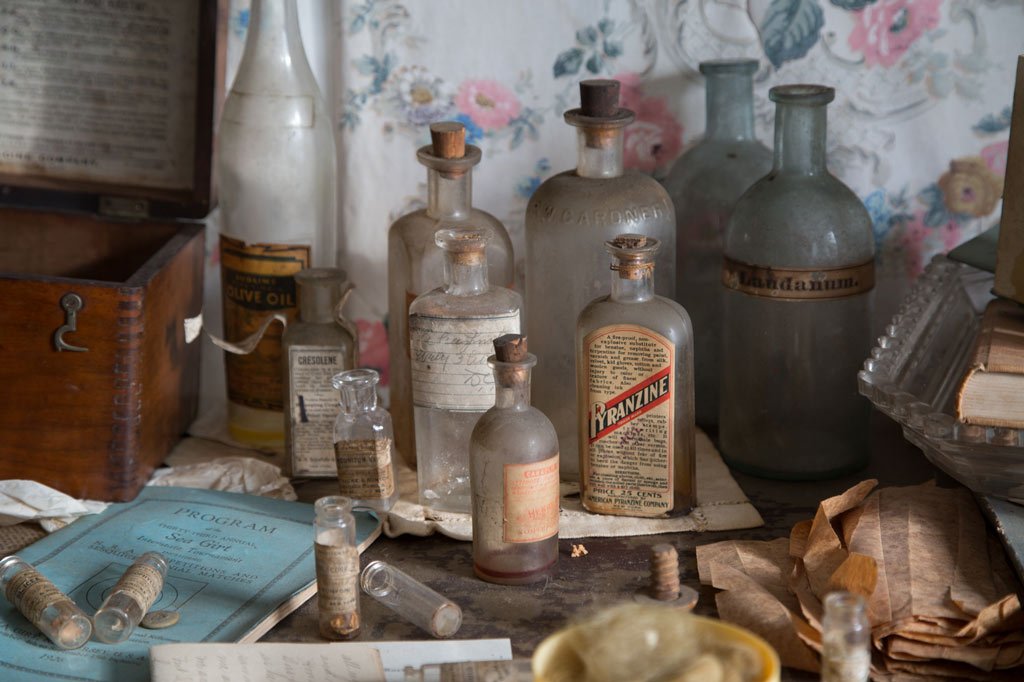
An Array of Historical Items
Pots, pans, glass bottles are scattered about the room. Collectors are now snapping vintage bottles like these, hoping to own a great article of the past—some packages contained standard household products such as olive oil and even Milk of Magnesia.
There is even a small brochure that reads: “Program of the Thirty-Third Annual Sea Girt Interstate Tournament.” The event was staged by the American International Riflers Association in nineteen twenty-six.

The Attic Storage Room
The farmhouse not only has a basement, but it also has attic storage areas. Here, too, beds are implying the room was also utilized for sleeping — probably for staff members.
The walls have many steel crinoline dresses hanging from the wall. This under-skirt gained popularity throughout Europe and North America after being patented in the mid 19th century. Given their age, these seem to be in excellent condition.
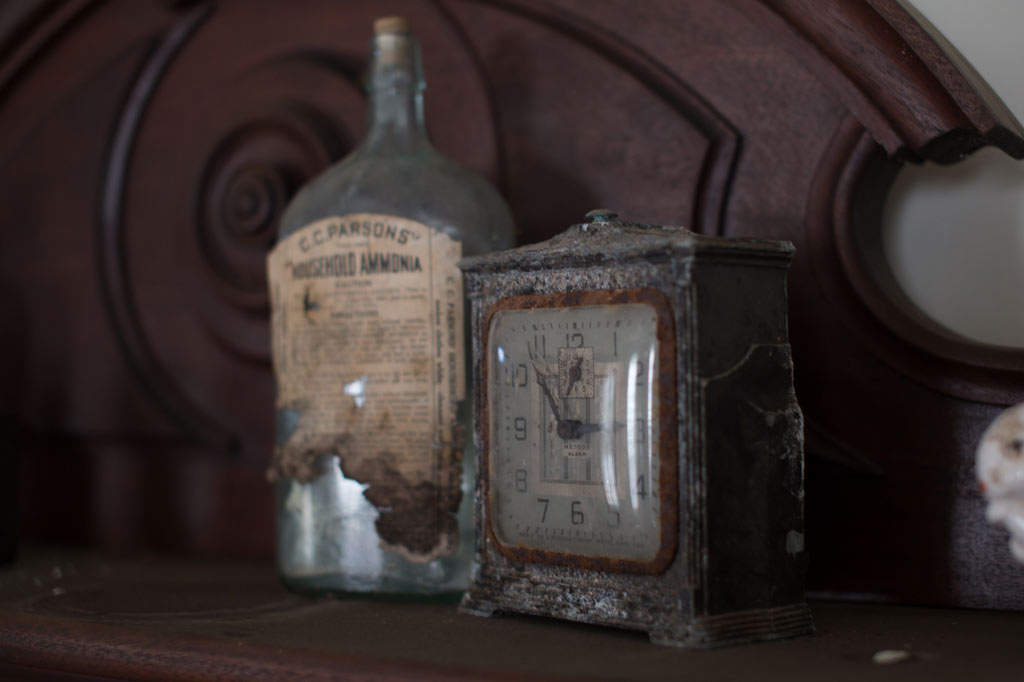
Time Frozen
This alarm clock has hands frozen in time at 2:54. Next is a glass bottle that once held C. Household ammonia, a prominent home cleaning agent.
Vintage treasure hunters striving to explore the property for themselves are out of luck. After Sansivero’s work, the house was empty. “The valuables have been cleared out now, and both security and cameras keep watch on it 24/7,” he says.

A Still Art Piece
These artificial flowers have withstood the test of time. Their colors are still rich and bright. A teacup sits next to the flowers as though awaiting someone to drink from it.
The upholstered furnishings here had not withstood well, although you can tell it looked nice when it was new. It’s scenes like this that compelled photographer Bryan Sansivero to say that the house felt so much like stepping back in time than any other he’d ever ventured in.

Outbuildings On The Property
The nine-acre farmstead has multiple structures, including an outhouse, garage, smokery, and various barns.
The inside of the barn is shown. The ancient farm tools in the facility assisted with exhibiting the property’s past as a working plantation. Carol asked that the buildings be kept as monuments.

Educator’s Desk.
Carol probably worked at this desk. While growing up in the farmhouse, she was enrolled in a single-room schoolhouse. Carll attended high school in Jamaica, Queens, then returned to her home town as an educator.
She invited students to tour the farm to learn about local history and farm existence leading to a local school renamed Marion E. Carll in 1957. We know Carll donated the property to the Commack School District.

Multiple Fireplaces
Fireplaces were typical in older homes before houses began getting central air systems. The Carll residence had numerous fireplaces. Some still look fantastic, including this one made of marble.
This would be quite welcoming to anyone sitting in the corner to read or have a conversation, especially on a frigid night. Except for the peeling wallpapers, the room is probably a good depiction of how it was when Carll lived there.

What Was In The Safe
The way the lock system is built on this safe has piqued many people’s interest in what it holds. It was built by Hall’s Safe Company, which is located in Cincinnati.
“A.J. McCarthy, D.D.S.” is engraved on the safe whom research shows as a former staff member at the University of Buffalo’s Dentistry Department It’s not ascertained how the safe got to the farm.
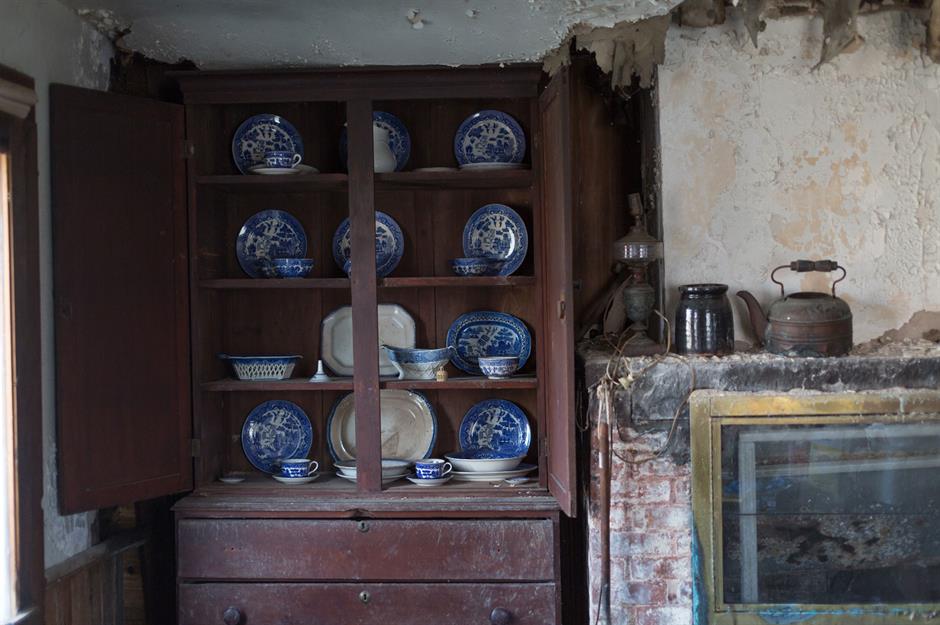
Heritage is Everywhere.
Sansivero said the house has a lot of history lying around. Every room brandished something new to observe, like this blue-and-white china set still in incredibly proper order.
There are numerous additional artifacts in this scene, like an oil lamp and a teapot. The roof in this compartment has deteriorated and now looks ready to fall apart.
Portions of the farmhouse were reasonably preserved, unlike others.
We visited a bedroom, and now we are upstairs the building. The top floor was used as a storehouse and lodging for the household staff.
The whole ceiling has collapsed, and the walls are smudged. Trash lines the ground. The hallway has many reminders of history.

Historic Places Register
Even though the estate is falling apart, it was placed on the National Register with more than a million other properties.
There are a few criteria to be on the register, and properties must meet one including, having made a substantial contribution to American history, being linked to a notable individual, having unique architectural aspects, or being critical to history.
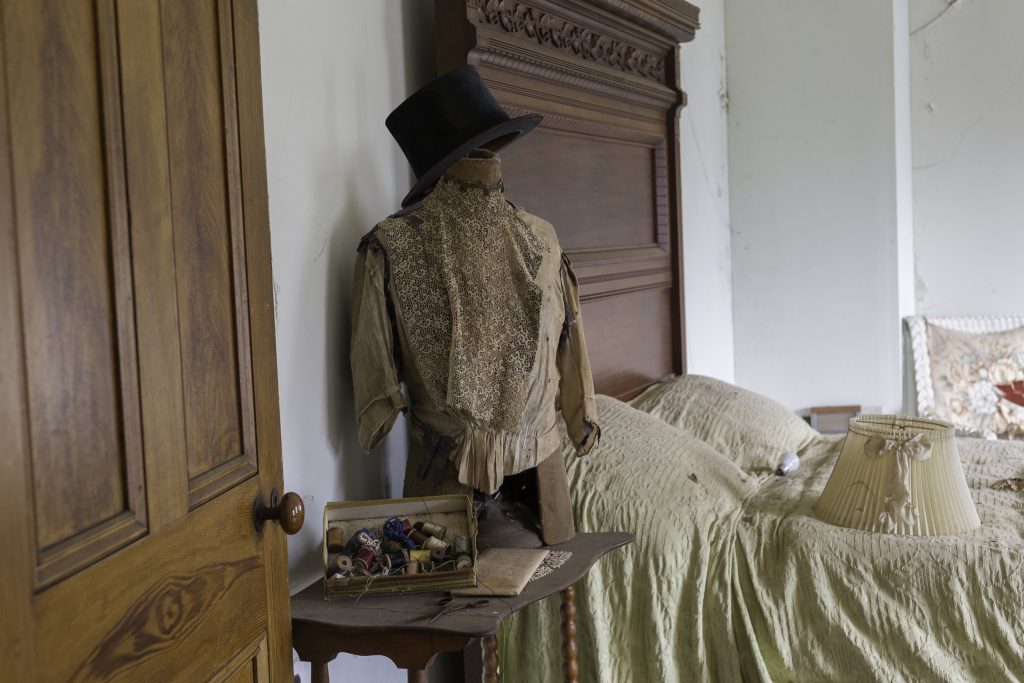
Great Embroidery Work
A blouse on a mannequin and a container with spools of thread were seen in the home’s main bedroom. Ms. Carll appeared to be a great stitcher.
Despite being exposed for so many years, the blouse exhibited great detail and elaborate embroidery endeavor. Maybe Ms. Carll designed it.
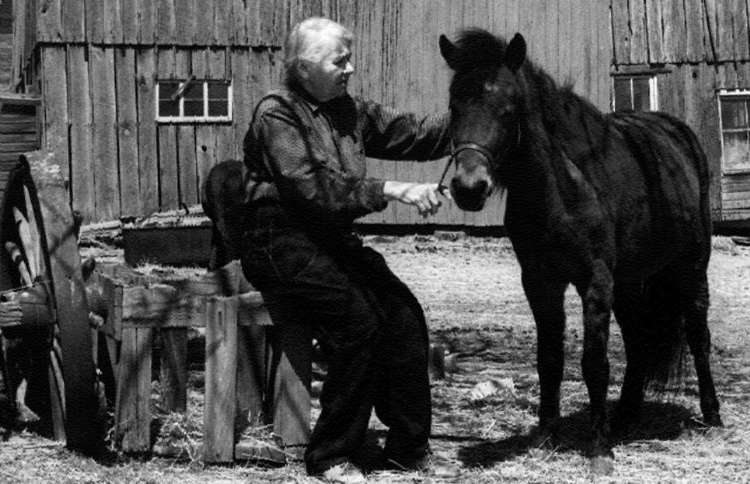
The Carll’s History
This image shows Carll around the mid-1900s. The photo’s website says Carll’s sister and two brothers were police officers, and her daughter owned a factory that made men’s shoes.
The Carll family has a prosperous history on Long Island comprising ties to Sagitikos Manor, which transferred to the Thompson family of Setauket, then to the Gardiner family. At the same time, the Carlls went on to be distinguished fellows of neighborhoods in and around the Huntington region.

Endangered Status
Ten years ago, the nonprofit SPLI recorded the Carll Farmstead as an endangered historic place. Robert Hughes is the historian of Huntington. He nominated the estate. He said they have an incredible time capsule due to the historic structures and artifacts.
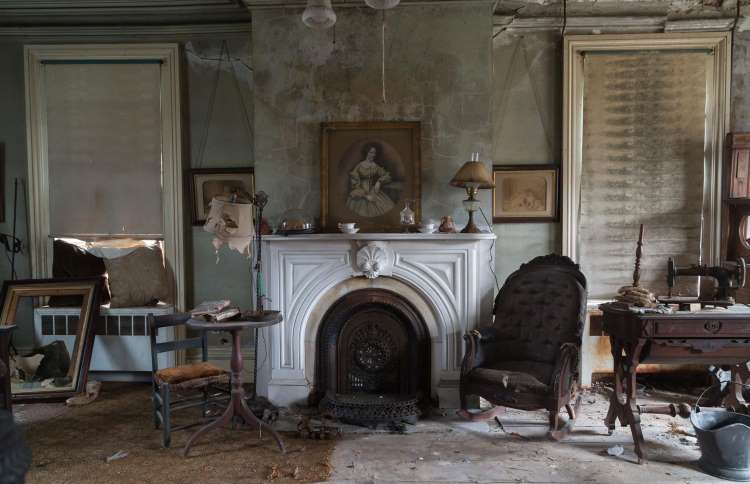
Preserving The Farm
A council with the Commack school district and locals have been laboring to examine the appropriate use of the notable Carll farm, which is a portion of the town park.
The team working to save the Carll Farm says they are striving to make it a restored historic location, and recommendations include a functional organic farm and a teaching center.
Amazing
Utah Woman Donates Kidney to Man She Met on a Hike

In an inspiring turn of events, a Utah County woman donated her kidney to a man she had only recently met on a hike.
Krissy Miller crossed paths with Shiller Joseph while hiking on Y Mountain, near Brigham Young University, in September 2023. During their chance meeting, Miller, a 49-year-old mother of four, learned that Joseph was in desperate need of a kidney. Without hesitation, she offered one of hers. Following medical tests, it was confirmed that they were a compatible match.
The story took an even more heartwarming turn when, after their initial encounter, Miller presented Joseph with what appeared to be a box of rolls. But inside the box was a sign that revealed her incredible gift — she would be his kidney donor.
On Monday, the pair reunited at Intermountain Health in Murray after a successful transplant surgery. Their emotional meeting came after months of preparation and surgery that gave Joseph, 45, a new chance at life.
Joseph, who has lupus, had been on the kidney transplant waiting list for some time. The average wait time for a kidney transplant in the U.S. is three to five years, with more than 90,000 people currently waiting for a life-saving organ. The National Kidney Foundation estimates that around 20 people die each day while waiting for a transplant, underscoring the critical need for organ donors.
Miller’s decision to donate her kidney without hesitation showcases the profound impact one person can make in the face of overwhelming need. This act of kindness not only saved Joseph’s life but also shines a spotlight on the importance of organ donation.
Amazing
A Young Hero for Hens
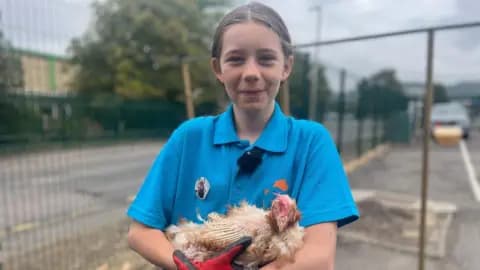
Harriet, a 12-year-old from Chart Sutton, Kent, is making a difference in the lives of farm hens. Every Saturday morning, she volunteers with Fresh Start For Hens, a local charity dedicated to finding new homes for commercial egg-laying hens.
These hens, typically 72 weeks old, are often destined for slaughter when their egg production declines. However, Fresh Start For Hens buys them from farms and rehomes them as pets.
At collection points like the one in Aylesford, Harriet helps transfer over 100 hens from farms to their new owners. The charity ensures potential adopters provide suitable living conditions for the hens, requiring photos of coops and runs, along with a minimum donation of £2.75 per bird.
Many of these hens arrive in poor condition, sometimes even bald from stress-induced feather pecking. Harriet explains, “They get quite bored, so they peck each other and rip out their feathers.” Remarkably, after a few weeks in their new homes, most hens regain their feathers.
Harriet’s dedication earned her the BBC Young Reporter award. She hopes her story will inspire more farmers to choose rehoming over slaughter for their hens. As Harriet puts it, “It makes me feel proud that I can do something for these chickens, save their lives and give them to these happy families.”
The charity operates entirely on volunteer efforts. Petrina Thomas, who leads collection mornings, believes they’re all motivated by a simple principle: “the love of hens.”
Amazing
Social Media Miracle: Stranger’s Selfless Act Saves Baby’s Life

Amazing human kindness helped give a six-month-old girl named Helin Dinlera second chance at life. It’s all thanks to the generosity of a stranger who responded to an urgent online plea. Helin, diagnosed with a rare and life-threatening liver condition called Biliary Atresia, faced a grim prognosis without a liver transplant.
When no family members were found to be suitable donors, Helin’s mother, Anna Shushura, turned to social media in a desperate attempt to find help. Her emotional appeal caught the attention of Letty Fenlon, a 27-year-old show jumper from Yorkshire, who felt compelled to act.
Letty, already registered as an organ donor, underwent extensive testing and was confirmed as a match for Helin. Despite the risks associated with major surgery, Letty’s determination to help prevailed. In May, she underwent a six-hour procedure to donate a portion of her liver to the infant.
The transplant was successful, and now, at nine months old, Helin is thriving. While she still requires regular medical check-ups, her progress has been remarkable. Helin’s family expresses immense gratitude towards Letty, whose selfless act has given their daughter a chance at a normal life.
Amazing
Trust and Perseverance: The Remarkable Rescue of Lessie from the Boundary Waters
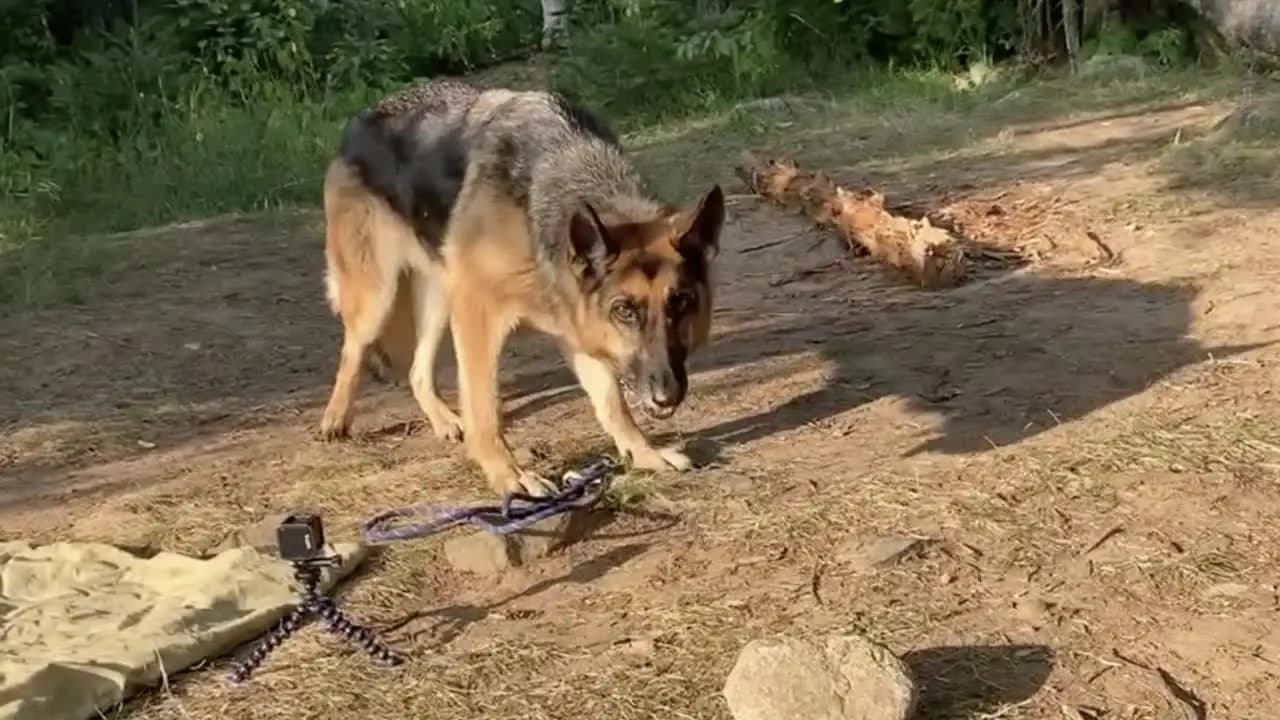
A heartwarming tale of survival and rescue has emerged from Minnesota’s Boundary Waters, where a German Shepherd named Lessie was found after being lost for 55 days. This story highlights the importance of trust-building and community effort in reuniting lost pets with their families.
Lessie’s ordeal began when she escaped following a car accident on the Gunflint Trail near Grand Marais in late June. The Retrievers, a non-profit organization dedicated to finding missing dogs, immediately mobilized to assist in the search.
After a month of uncertainty, hope was rekindled when Lessie was spotted near Ham Lake, miles from the accident site. A Minneapolis-based volunteer, familiar with the area, stepped up to help. Armed with guidance from The Retrievers and his previous experience, he set up camp to search for Lessie.
The volunteer’s patient approach proved crucial. Using food and a trail camera, he gradually gained Lessie’s trust over several days. His persistence paid off when he finally managed to leash Lessie and lead her to safety, facilitating an emotional reunion with her owners.
Jennifer Cadigan of The Retrievers emphasized the intelligence and resilience of dogs, noting that Lessie likely survived on discarded fish remains from nearby campsites. This remarkable story serves as an inspiring reminder to never lose hope when searching for a lost pet.
The successful rescue of Lessie after nearly two months in the wilderness underscores the effectiveness of combining community involvement, expert guidance, and unwavering determination in resolving missing pet cases.
Amazing
Freedom at Last: Charlie the Elephant Begins New Life After Four Decades in Captivity

A momentous event in South African wildlife conservation has unfolded with the release of Charlie, the country’s last zoo elephant, into a natural habitat after 40 years of confinement. This historic transition marks the end of an era for elephant captivity in South African zoos and represents a significant victory for animal welfare advocates.
Charlie’s journey began in 1984 when he was taken from Zimbabwe’s Hwange National Park as a two-year-old calf. His life in captivity included years of performing in a circus before being transferred to South Africa’s national zoo in the early 2000s. During his time at the zoo, Charlie reportedly experienced the loss of four fellow elephants, including his own offspring.
The push for Charlie’s release gained momentum in recent years as concerns about his well-being grew. Animal welfare organizations, including the EMS Foundation and Four Paws, played crucial roles in negotiating with the South African government and providing scientific evidence of the detrimental effects of captivity on elephants.
After a tense four-hour journey, Charlie arrived at his new home in the Shambala Private Reserve in Limpopo province. This 10,000-hectare sanctuary, known for its success in reintegrating animals into the wild, now hosts Charlie as he begins his rehabilitation process.
Veterinary and behavioral experts are closely monitoring Charlie’s adaptation to his new environment. Early signs are promising, with reports of Charlie showing excitement upon hearing other elephants and attempting to communicate with them. However, the rehabilitation process is expected to be gradual, allowing Charlie to rediscover his natural instincts and potentially integrate with the reserve’s existing elephant population.
This release not only signifies a new chapter for Charlie but also represents a broader shift towards improved animal welfare practices in South Africa. As the country continues to grapple with challenges facing its wild elephant population, including poaching and habitat loss, Charlie’s story serves as a reminder of the importance of conservation efforts and the ethical treatment of wildlife.
-

 OMG6 years ago
OMG6 years agoA Couple Gave Birth to the Most Beautiful Twins Ever
-

 OMG7 years ago
OMG7 years ago20 Rare Historical Photos
-

 OMG6 years ago
OMG6 years agoHilarious Airport Photos
-

 Cute6 years ago
Cute6 years agoMom Refuses to Let Daughter Eat Sugar and Years Later This is What She Grows Into
-

 OMG6 years ago
OMG6 years agoTop Secret Air Force One Facts That You Never Knew
-
OMG6 years ago
The Funniest Yearbook Photos Of All Time
-

 OMG6 years ago
OMG6 years agoRetired Mathematician Restores Log Cabin
-

 OMG5 years ago
OMG5 years agoWhat Happened When This ‘Duck Dynasty’ Legend Chopped Off His Beard?